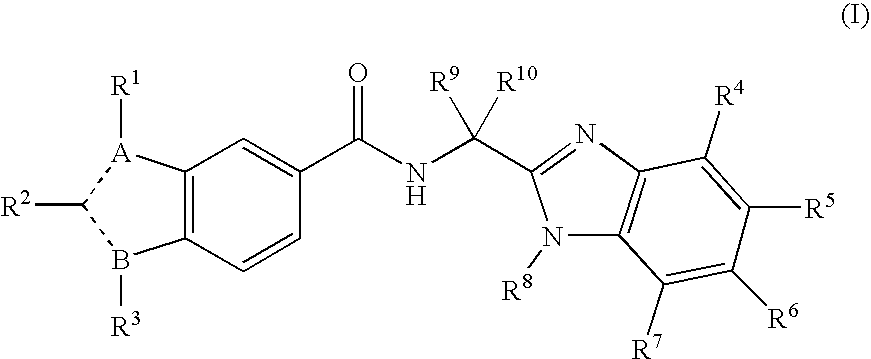Viral polymerase inhibitors
a polymerase inhibitor and polymerase technology, applied in the field of hcv polymerase, can solve the problems of no vaccine to prevent hcv infection, and achieve the effects of inhibiting rna synthesis, good activity, and inhibiting activity
- Summary
- Abstract
- Description
- Claims
- Application Information
AI Technical Summary
Benefits of technology
Problems solved by technology
Method used
Image
Examples
example 1
3-(3,3-Difluorocyclopentyl)-1-methyl-1H-indole-6-carboxylic acid methyl ester
[0372]
Step 1:
[0373] Indole-6-carboxylic acid 1-1 (5.0 g, 31.0 mmol) was dissolved in MeOH (100 mL), a catalytic amount of H2SO4 (1.0 mL) was added and the reaction mixture was stirred at reflux for 16 h. A small amount of solid K2CO3 was added, in order to neutralize the excess H2SO4, and stirring was continued at RT for 1 h. The reaction mixture was concentrated under vacuum to remove the MeOH, diluted with saturated aqueous NaHCO3 (˜50 mL) and extracted with EtOAc (˜200 mL). The organic layer was washed with brine (100 mL), dried over anhydrous MgSO4 and concentrated to dryness. The resulting residue was purified by flash column chromatography, using 30% EtOAc in hexane as the eluent, to obtain the pure methyl ester 1-2 (4.78 g, 88% yield).
Step 2:
[0374] The methyl ester 1-2 from step 1 (3.31 g, 18.9 mmol) was dissolved in MeCN (50 mL) and a catalytic amount of Yb(OTf)3 (586 mg, 0.95 mmol) was added....
example 2
(E)-3-(3-Amino-4-methylaminophenyl)acrylic acid methyl ester
[0378]
Step 1:
[0379] A mixture of 4-chloro-3-nitrocinnamic acid 2-1 (500 mg, 2.2 mmol) and a solution of methylamine in THF (2M, 8 mL, 16 mmol) were heated in a sealed tube at 80° C. for 20 hours. The mixture was then cooled to room temperature and concentrated to an orange solid 2-2 that was used in the following step without further purification.
[0380] It will be apparent to the person skilled in the art that other diamine intermediates of general formula IV in Schemes 2 and 3 above, where R8 is other than methyl, may be prepared by replacing methylamine (CH3NH2) in step 1 above with the appropriate R8—NH2.
Step 2:
[0381] The crude 4-methylamino-3-nitrocinnamic acid intermediate 2-2 from step 1 (488 mg, 2.2 mmol) was dissolved in methanol (20 mL) and an ether solution of diazomethane was added until HPLC analysis indicated complete conversion of the acid to the methyl ester. The solution was concentrated to dryness to...
example 3
(E)-3-[2-(1-Aminocyclobutyl)-1-methyl-1H-benzoimidazol-5-yl]acrylic acid methyl ester
[0383]
(E)-3-(3-Amino-4-methylaminophenyl)acrylic acid methyl ester 24 from Example 2 (40 mg, 0.194 mmol) was suspended in CH2Cl2 (3 mL) and 1-aminocyclobutanecarboxylic acid chloride hydrochloride, prepared from 1-aminocyclobutanecarboxylic acid following an adaptation of the procedure described by E. S. Uffelman et al. (Org. Lett. 1999, 1, 1157), (31 mg, 0.18 mmol) was added. The reaction mixture was stirred at room temperature for 2 hours and then concentrated to obtain a white solid. The solid was then dissolved in acetic acid (5 mL) and heated to 60° C. for 20 hours. The reaction crude was diluted with aqueous saturated NaHCO3, extracted with CH2Cl2 (2×50 mL) and brine, the organic layer was dried over anhydrous MgSO4 and the solvent was removed under reduced pressure to give (E)-3-[2-(1-aminocyclobutyl)-1-methyl-1H-benzoimidazol-5-yl]acrylic acid methyl ester 3-1 as a light brown foam (53 mg)...
PUM
| Property | Measurement | Unit |
|---|---|---|
| volume | aaaaa | aaaaa |
| volume | aaaaa | aaaaa |
| pH | aaaaa | aaaaa |
Abstract
Description
Claims
Application Information
 Login to View More
Login to View More - R&D
- Intellectual Property
- Life Sciences
- Materials
- Tech Scout
- Unparalleled Data Quality
- Higher Quality Content
- 60% Fewer Hallucinations
Browse by: Latest US Patents, China's latest patents, Technical Efficacy Thesaurus, Application Domain, Technology Topic, Popular Technical Reports.
© 2025 PatSnap. All rights reserved.Legal|Privacy policy|Modern Slavery Act Transparency Statement|Sitemap|About US| Contact US: help@patsnap.com



